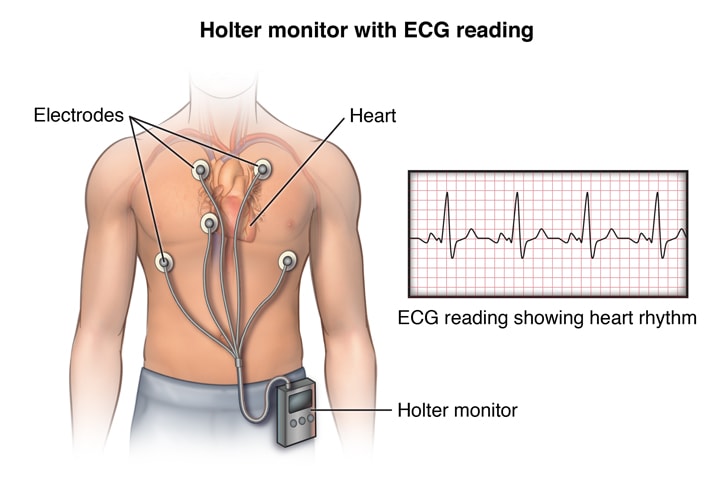Holter Monitor

A Holter monitor is a small, battery operated, mobile electronic device worn for 24-48 hours to continuously record your EKG (heart’s electrical activity) for 24-48 hours. The monitor is very small, about the size of a cell phone, and not cumbersome. Electrodes are placed on your chest and connected by wires to the monitor itself. There are no risks to wearing the device and it is not painful. A diary is provided for you to record any symptoms that occur during the testing period. You will be asked to remove the device after the monitoring time is over and return it to your doctor.
Who may need a Holter Monitor?
Those having symptoms such as
- Fainting or near fainting
- Fast heart beat
- Slow heart beat
- Irregular heart beat
Those who have received treatment for their cardiac arrhythmia may have a repeat Holter monitor to determine the effectiveness of treatment.
What to expect with your test
A technician will place the electrodes on your chest. You may even be able to leave your clothes on as the electrodes are being placed. The technician might need to shave hair where the electrodes are to be placed on the chest.
While wearing the monitor you should go about your usual activities except for the following:
- Do not bathe, shower or swim while wearing the monitor
- Do not have x-rays while wearing the monitor
- Do not go near high-voltage areas, metal detectors or large magnets such as those used in MRI’s
What are the risks of the test?
There are no risks and there is no pain involved. There is no electrical current that is sent into your body. The monitor only records the electrical activity of the heart. Supplies for the Holter monitor are latex free however it is always wise to let the technician know if you have a latex allergy or if you have certain skin sensitivities. Because the electrodes are attached with adhesive, occasionally minor skin irritations can occur. Rarely, a monitor will have to be removed early due to more significant skin irritations.
What to expect after the test
Once the monitor is returned to the physician’s office the technician will retrieve the information from the monitor and your physician will review the data and the symptoms that you recorded in the diary. You should get the results of the test within 1 week. The information obtained from this test is used to help make recommendations about possible causes of your symptoms and also aid in selecting treatment options or further diagnostic testing.
How to prepare for the test
There is no preparation required but it is preferable that you avoid lotions on the chest.
